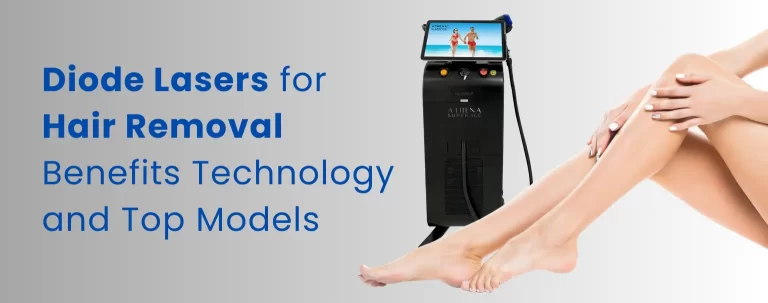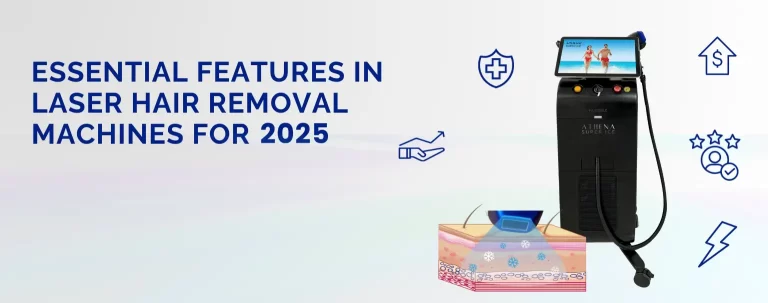Understanding the Different Types of Laser Hair Removal Machines
One of the most common skincare problems is unwanted hair!
Women spend long hours shaving their legs before a date or other big occasion. This is not only time-consuming but also annoying. So, to provide them with a foolproof solution, the medical aesthetics industry developed the hair removal machine.
Though this technology has changed women’s and men’s lives, innovations have made it difficult for people to pick the right one. Not all technologies are created equal. We have rounded up the different types of hair removal machines to help you make the right decision based on your skin and hair type.
Let’s begin:
Alexandrite Laser Machine
Alexandrite laser operates using a wavelength that falls within the lesser range of laser wavelengths, at 755 nanometers (nm). This lets the laser focus on the hair follicle without damaging the surrounding skin. As a result, it is extremely effective at targeting melanin, the pigment found in both skin and hair. Thanks to its bigger spot size, the laser can cover more ground in less time.
Best For
- Fair to light olive skin tones (Fitzpatrick skin types I-III).
- Dark, coarse hair.
- Large areas like the legs, arms, and back because of their speed.
Advantages
- Fast treatment times due to the large spot size.
- High efficacy for lighter skin tones with dark hair.
Disadvantages
- Not suitable for darker skin tones due to the higher risk of skin damage.
- Less effective on lighter hair colors, such as blonde, grey, or red.
Diode Laser Machine
Compared to the Alexandrite laser, the diode laser has a wavelength of 810 nm. This allows it to penetrate deeper into the skin. The wavelength works well on a broader spectrum of skin tones because it balances melanin absorption with skin safety.
Best For
- Light to medium-dark skin tones (Fitzpatrick skin types I-IV).
- Dark to medium-colored hair.
- Small to medium-sized areas like the face, underarms, and bikini line.
Advantages
- Deeper penetration makes it safer for slightly darker skin tones.
- Effective on both fine and coarse hair.
- Longer-lasting results with fewer sessions required.
Disadvantages
- May take longer for larger treatment areas.
- Not ideal for very dark skin or very light hair.
Nd:YAG Laser Machine
ND laser avoids melanin in the epidermis, using a wavelength of 1064 nm, reaching even deeper into the skin. Since it targets the hair follicle without burning the surrounding pigment, it is considered the safest choice for darker skin tones.
Best For
- Medium-dark to very dark skin tones (Fitzpatrick skin types IV-VI).
- Dark, coarse hair.
- Effective for both smaller and larger areas.
Advantages
- Safe for all skin tones, particularly darker skin.
- Low risk of hyperpigmentation or burns in darker skin types.
Disadvantages
- Less effective on finer or lighter-colored hair.
- Can be more uncomfortable compared to other laser types.
- Slower treatment times due to smaller spot sizes.
Ruby Laser Machine
Ruby laser uses a 694 nm wavelength, the shortest of all lasers. It absorbs melanin at a high rate. This is why it works well on light skin tones and dark hair. However, due to its drawbacks and the availability of more sophisticated technology, it is hardly utilized anymore.
Best For
- Fair skin tones (Fitzpatrick skin types I-II).
- Dark, fine hair.
- Smaller areas like the face and underarms.
Advantages
- Very precise for small areas.
- Effective for removing fine and light-colored hair.
Disadvantages
- Limited to very light skin tones; unsuitable for medium to dark skin.
- Risk of side effects like pigmentation changes in darker skin.
- Slower treatment times due to smaller spot size and older technology.
IPL Machine (Intense Pulsed Light)
Although not a true laser, IPL (Intense Pulsed Light) uses a broad spectrum of light wavelengths that scatter across the skin to target hair follicles. The light energy converts to heat, destroying the follicle and preventing future hair growth.
Best For
- Fair to light olive skin tones (Fitzpatrick skin types I-III).
- Dark hair.
- Effective for both large and small areas.
Advantages
- Can be used for skin rejuvenation as well as hair removal.
- Cost-effective compared to laser machines.
Disadvantages
- More affordable than laser technology.
- More sessions are required to achieve similar results.
- Higher risk of side effects for darker skin tones.
Conclusion
Choosing the right hair removal machine is essential to ensuring your clients leave your medspa satisfied and happy. You must consider the immediate results and the long-term effects to give your clients a complete plan they can follow according to their budget. Since hair removal requires multiple sessions, some people find it expensive. This is why you need to make an informed decision.
To recap, here’s what each machine offers:
- Alexandrite Laser is best for fine hair and lighter skin tones, offering quick treatment.
- Diode Laser is known for its efficacy and precision in thick hair.
- ND Laser is especially effective for darker skin tones.
- Ruby Laser is a dependable option for small treatment areas and pale skin.
- IPL (Intense Pulsed Light) offers a broad-spectrum approach. However, it requires more sessions.
The Athena SUPER ICE Diode Laser by Pro Laser Tech is a Gold Standard Technology authorized by Health Canada. The device contains state-of-the-art features that allow Medspas to increase its clientele and profits. To book a demo, visit our website or call (416) 839-3872.


